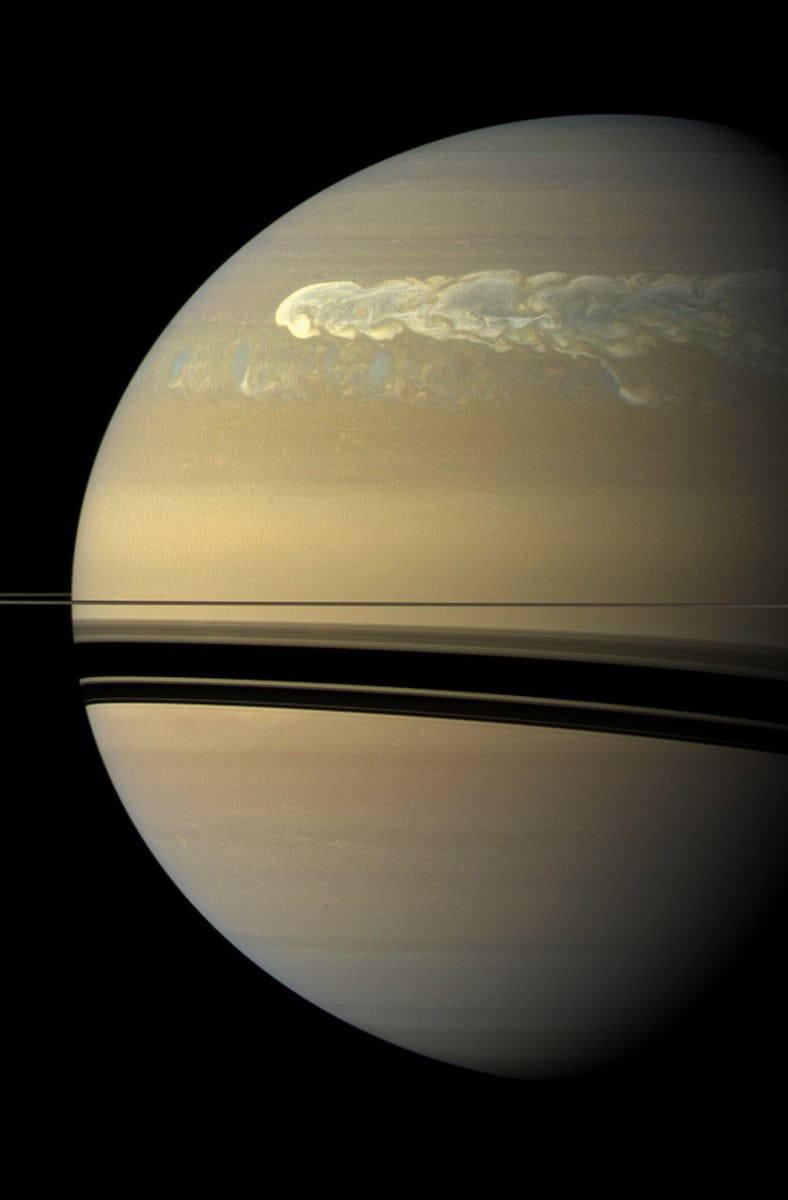The Aftermath of Saturn's Giant Storms Lasts for Centuries
Giant storms on the ringed planet can leave patches of ammonia trapped in the lower atmosphere for centuries, a recent study suggests.

Saturn’s giant storms leave ammonia footprints in the lower atmosphere that last for centuries after the storm has blown itself out.
Every decade or two, Saturn spawns a truly enormous storm. Winds roar at up to a thousand miles an hour, trails of storm clouds wrap around the whole planet, and hail made of ammonia rattles downward. The storm finally peters out after more than six months, but its impact on Saturn’s atmosphere will last much longer, according to a recent study by University of Michigan planetary scientist Cheng Li and his colleagues. They recently discovered that Saturn’s giant storms carry ammonia vapor deep into the planet’s atmosphere, where it can linger for centuries, like a footprint to mark the storm’s passage.
Li and his colleagues published their research in the journal Science Advances.
The huge storm churning through the atmosphere in Saturn's northern hemisphere overtakes itself as it encircles the planet in this true-color view from NASA's Cassini spacecraft.
How Giant Storms Leave Footprints in the Sky
Saturn’s uppermost cloud decks are mostly ammonia (a nitrogen atom bonded to three hydrogen atoms), floating in an atmosphere of hydrogen. At deeper, warmer altitudes, the clouds are mostly water. But in data from the Very Large Array radio telescope, Li and his colleagues spotted radio emissions from patches of ammonia trapped in the lower layers of Saturn’s atmosphere, where it usually shouldn’t be.
The out-of-place ammonia was drifting at around 43 degrees north latitude, where NASA’s Cassini spacecraft (RIP) watched a giant, planet-spanning storm in 2010 (Saturn’s winds mostly blow east and west, which is why the giant storms tend to be long and narrow — and why weird features in the atmosphere tend to stay at the same latitude that spawned them).
The storm lasted a little more than six months, and Li and his colleagues say it carried ammonia from high-altitude clouds into the lower layers of the atmosphere — where it’s now stuck.
Using the VLA data, Li and his colleagues spotted several other swathes of misplaced ammonia in Saturn’s lower atmosphere. And they mostly matched the latitudes of the five other huge storms astronomers have observed swirling around Saturn since 1876. That means that some of those ammonia clouds have been trapped in Saturn’s lower atmosphere for almost 120 years.
One patch of ammonia Li and his colleagues spotted doesn’t match any of the recorded storms, so it may be more than 150 years old: a cloudy footprint of a storm human eyes never saw.
Mushballs Are the Weirdest, Coolest Precipitation
Part of the explanation may be what Li and his colleagues call mushballs: little balls of ice with a liquid blend of ammonia and water inside (like Gushers candy, except unflavored and also poison). The mushballs fall from storm clouds in the higher levels of Saturn’s enormous storms, carrying ammonia deeper into the atmosphere.
This false-color image from NASA’s Voyager 1 spacecraft reveals Saturn’s clouds in detail.
In the wake of the storm, the upper atmosphere stays warm for a while; it’s also dry, having dropped so much of its ammonia in a hail of mushballs. For a while, the upper layers of the atmosphere are warmer than the layers beneath, and that warm, dry air acts as a lid, keeping the ammonia clouds trapped in the layer below.
Even a storm as tremendous and powerful as Saturn’s decadal storms can’t leave footprints in the clouds forever, though. Eventually, the turbulence of Saturn’s atmosphere will mix the storm-heated air with cooler air from other latitudes, and the trapped banks of ammonia clouds will be free to rise. And eventually, another storm will come along.
Where Do We Go From Here?
When Li and his colleagues studied the swaths of trapped ammonia left by giant storms on Saturn, they noticed that each “footprint” tends to split in two. One patch of ammonia drifts northward from the latitude of the storm, while the other patch drifts south. That’s one of the things they want to study in more detail with future observations.
It’s challenging enough to predict the weather here on Earth, let alone on a turbulent alien world like Saturn, but history suggests that another giant storm should flare up and wrap itself around the planet in the next ten to twenty years. When that happens, Li and his colleagues hope astronomers and planetary scientists will study how the storm evolves and what happens to Saturn’s atmosphere in its aftermath.
Meanwhile, the team plans to look at Saturn’s southern hemisphere in 2025. The VLA data Li and his colleagues used for their recent study only covered the planet’s northern hemisphere, because at the moment, the tilt of Saturn’s axis means the southern hemisphere is demurely hiding behind the planet’s iconic rings. By 2025, Saturn will be at a different point in its orbit, and telescopes on Earth will be able to see the southern hemisphere.
All of the giant storms astronomers have observed so far have happened in the planet’s northern hemisphere, so Li and his colleagues predict that, if they’re right, they shouldn’t see any trapped patches of ammonia in the south.
This article was originally published on